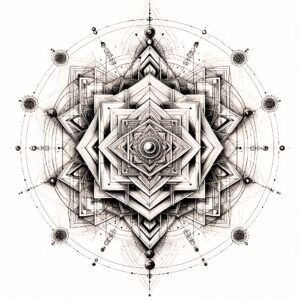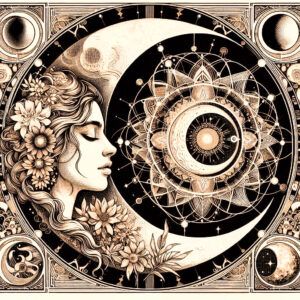
CONCEPT:
Yantra
Pronunciation:
/ˈjʌntrə/
Definition:
A Yantra is a geometric diagram composed of interlocking triangles, circles, and other shapes, used in Hindu and Buddhist Tantric traditions for meditation and spiritual practices. Each yantra is associated with a specific deity or cosmic principle, believed to embody the energy and essence of that deity or principle.
Other Concepts
Deeper Understanding
The concept of the Yantra is deeply embedded in the spiritual and cultural fabric of Hindu and Buddhist Tantric traditions. These intricate geometric diagrams serve as visual tools for meditation, concentration, and energy channeling. Each yantra is meticulously designed to represent and invoke the specific energy of a deity or cosmic principle, providing a sacred means of connecting with the divine.
Yantras are composed of various geometric shapes, including interlocking triangles, circles, and lotus petals, each symbolizing different aspects of the universe and the divine. The most renowned yantra is the Sri Yantra, associated with the goddess Lalita or Tripura Sundari, which consists of nine interlocking triangles radiating from a central point. This complex design is considered a visual representation of the cosmos and the body of the goddess, embodying her divine energy and the principles of creation, preservation, and destruction.
Historically, yantras can be traced back to ancient Indian traditions, with evidence of their use dating to the Indus Valley Civilization. These sacred diagrams are described in ancient texts such as the Vedas and the Tantras, where they are revered as powerful tools for spiritual growth and transformation. Yantras are often drawn on altars, etched onto metals, or painted on canvases, and are sometimes worn as amulets to invoke the protection and blessings of the deity they represent.
In spiritual practice, yantras are used as focal points for meditation. Practitioners believe that by concentrating on the yantra, one can channel the specific energy it represents, aiding in the attainment of higher states of consciousness. The symmetrical and repetitive nature of yantras is thought to help calm the mind, enhance focus, and facilitate a deeper meditative state. This belief is supported by modern studies in psychology, which suggest that geometric patterns and symbols can have a calming effect on the mind, promoting relaxation and mental clarity (Ramakrishna Rao, K., 1991).
Yantras are not only significant in spiritual practices but also in the study of sacred geometry. Sacred geometry explores the symbolic and sacred meanings attributed to certain geometric shapes and patterns, and yantras are a quintessential example of this field. The precise and symmetrical designs of yantras are believed to mirror the inherent order and harmony of the universe, making them objects of both spiritual reverence and aesthetic appreciation.
In contemporary times, yantras continue to hold relevance for their spiritual and cultural significance. They offer a visual representation of complex spiritual concepts and serve as powerful tools for meditation and spiritual practice. The use of yantras in meditation can enhance concentration and focus, providing a tangible means of connecting with the divine. Moreover, their study contributes to the broader understanding of sacred geometry and the universal patterns found in nature and art.
References
Ramakrishna Rao, K. Yantra, Mantra, and Tantra. Vishwa Bharati Publications, 1991.
Khanna, Madhu. Yantra: The Tantric Symbol of Cosmic Unity. Inner Traditions International, 2003.
Stutley, Margaret. The Illustrated Dictionary of Hindu Iconography. Munshiram Manoharlal Publishers, 2003.

